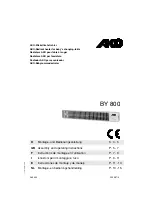
8
78570
Typical Gas Line Connection
Step 1: With the engine assembly free from the fireplace,
check tightness of flexible connector fittings.
CAUTION: Use one wrench to hold regulator and one
wrench to loosen and tighten the brass fittings. Failure to
hold the regulator while loosening and tightening the
fittings can damage the unit and cause gas leaks.
Step 2: Set the engine assembly into the fireplace and connect
the flexible connector to the gas piping that has been installed
per local codes, or in the absence of local codes, ANSI Z223.1
latest edition.
Step 3: After the last connection is made, screw the engine
assembly to the bottom of the fireplace. (Fig. 3)
Step 4: Test all connections for gas leaks.
Fig. 5 Typical drip leg (sediment trap) configurations.
2
2
2
1
Less Than 6’
If using flexible
connector, check local
codes for specific
requirements
Piped Gas Supply
Drop
Manual Shut-Off Valve
Horizontal
Ground Joint
Union
Tee
Fitting
Nipple
3”
Min.
Cap
1/8” N.P.T. Plugged
Hole for Test Gauge
Gas
Valve
Drop
Manual Shut-Off
Valve
Ground Joint
Union
Tee
Fitting
Nipple
3”
Min.
Cap
1/8” N.P.T.
Plugged Hole
for Test Gauge
Gas
Valve
Tubing Gas Supply
Riser
Manual Shut-Off
Valve
Ground Joint
Union
Tee
Fitting
Nipple
3”
Min.
Cap
1/8” N.P.T.
Plugged Hole
for Test Gauge
Gas
Valve
Riser
Horizontal
Piped Gas Supply
Piped Gas Supply
1
All bends in metallic tubing should be
smooth, elbows are recommended.
2
CAUTION: Shut off the main gas supply before removing
end cap to prevent gas from filling the work area. Test for
gas leakage when installation is complete.
T130
Under no circumstances should internally zinc alloy coated piping be used. According to the LP-Gas Code and National Fuel Gas
Code - If galvanized piping is used, it must be EXTERNALLY coated only! Galvanized water pipe used for gas installations will
result in reduced gas pressure and gas leaks.






































